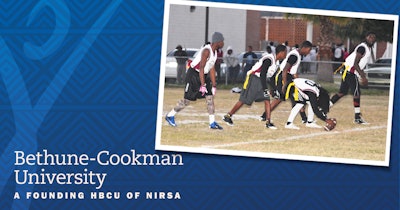
Located just west of the Halifax River and barely two miles away from the Main Street Pier of Daytona Beach in Daytona Beach, Fla., Bethune-Cookman University is a private HBCU that sits on an 85-acre urban campus. Lifelong educator and civil rights activist, Dr. Mary McLeod Bethune founded the Daytona Literary and Industrial Training School for Negro Girls, what would become Bethune-Cookman University (B-CU), in 1904.
Since its founding, the school has experienced several milestones of growth and development. In 1923 the school merged with Cookman Institute of Jacksonville, Florida, the state’s first institution of higher education for Black students. By 1931, the institution’s name was officially changed to Bethune-Cookman College, a moniker it held until 2007 when the school took on university status after adding a graduate program in transformational leadership to its offerings.

The university now confers 39 undergraduate degrees and six master’s degrees and is currently home to more than 2,700 students. B-CU is renowned for its small-university community feel and its HBCU sensibility, for its strong academics and exceptional, personalized teaching, and for carrying forward the legacy of Dr. Bethune. Her legacy includes a dedication to service and a commitment to building a vision for the future, then applying creativity, initiative, and resilience to bring success in college and in the world beyond.
About intramural and recreational programs
The Bethune-Cookman University’s Intramural and Recreational Sports department offers a variety of activities for students, faculty and staff that promote a positive and healthy experience. Among the experiential opportunities available to students are flag football, powder puff football, basketball, competitive video gaming, and other activities.

The Michael & Libby Johnson Center for Civic Engagement & Wildcat Student Center provides B-CU students a place to relax or work out. The Center contains a lounge, game room, and fitness center. The Game Room features two pool tables, a foosball table, a variety of table and board games, two flat-screen televisions, and a game console. The Lounge offers students a place to relax and connect around four flat-screen televisions, comfortable lounging furniture, and space for small events and activities. This is the place where B-CU students frequently hang out with friends, relax, and study. The Fitness Center is equipped with treadmills, exercise bikes, stair climber machines, bicep curl, triceps extension, horizontal leg press, deltoid/pectoral contractor, stand calf, and free weights.
Celebrating NIRSA’s founders
From the time two state schools in the Midwest devoted spaces and resources to campus recreation, a century of ever-growing commitment to programming, participation, inclusion, and outside-of-the-classroom learning has prevailed for students and faculty in higher education.
As more and more campuses began to offer recreational sports, these programs caught the attention of scholars who were interested in their positive effects on campus culture and students’ quality of life.
Dr. William Wasson was one such scholar, who discovered the value of intramurals studying Physical Education under Elmer Mitchell at the University of Michigan in 1946. He went on to develop his own intramural program at Dillard University, and in 1948 commenced a study, with funding from the Carnegie Foundation, titled “A Comparative Study of Intramural Programs in Negro Colleges.”
The results of his study were shared with the institutions that participated in his research. The discussion culminated in an Intramural Summit on the Dillard University campus on February 22, 1950; the 20 intramural directors gathered there, representing 11 Historically Black Colleges & Universities, formed the National Intramural Association (NIA), precursor to today’s NIRSA. The NIA was the first organization of its kind, bringing intramural program leaders to share skills and wisdom to advance the good work of their profession. Through Rudolph G. Matthews, Roosevelt Grattic, and Nelson Williams, Bethune-Cookman University—then known as Bethune-Cookman College—was one of the 11 schools represented at NIRSA’s founding.
Born August 14, 1915, Reverend Rudolph G. “Bunky” Matthews was the basketball and football coach at Bethune-Cookman College in 1950, when the National Intramural Association was founded. A member of the Bethune-Cookman Wildcats Hall-of-Fame, “Bunky” Matthews was one of the cornerstones of the Bethune-Cookman athletic department and his legacy has spanned many generations of Wildcat athletics.
According to the City of Daytona Beach—who named Bunky among their city’s Black History Icons in 2022—Matthews “grew up in Lakeland, Florida. He was born in Neeses, South Carolina, to Walter and Ethel Matthews. He was the second oldest child among three sisters, Alberta Matthews Kendly, Ruth Matthews Bird, and Doris Matthews Hernandez.”
In high school, Matthews was a star football player and he became a standout on the field for the Wildcats in the 1930s, when the program was still a junior college team. In 1937, he received an associate’s degree from Bethune-Cookman College before he matriculated to Morehouse College in Atlanta, Georgia, where he would earn a bachelor’s degree in English literature with a minor in French in 1939. He would go on to complete a master’s degree in physical education from Columbia University in New York City.
During his early professional career, he served as a teacher in Georgia, a head coach at Edward Waters College in Jacksonville, Florida; he also served in the European Theater of Operation during World War II and was honorably discharged with the rank of Master Sergeant. From 1946-1962, he served as athletic director and coach of the Bethune-Cookman College’s Wildcats’ football and basketball teams. Matthews left the sidelines in 1960 after two heart attacks, but stayed on campus in the physical education department. He served as Assistant Professor of Health and Physical Education from 1957 to 1976.
He went on to serve as a minister at Mount Bethel Baptist Church, the oldest Black church in Daytona Beach; where he was the church’s pastor from 1965-1976. In 1973, Matthews was elected to the Daytona Beach City Commission and was a sitting city commissioner when he passed away. Bunky Matthews passed away on September 28, after suffering a heart attack while watching the Mohammed Ali vs. Ken Norton world heavyweight championship fight. He was remembered as a devoted husband to his wife Chequita and father to daughter Tanya.
Matthews brought two B-CC students with him to New Orleans in February of 1950: Roosevelt Grattic and Nelson Williams.
Born in 1929, Theodore Roosevelt Grattic Jr. was a sophomore at Bethune-Cookman College in 1950. In August of 1954, he completed his Bachelor of Science degree with a major in physical education. He would go on to coach in the Fort Myers, FL area before passing away in 2002.
Nelson P. Williams Jr. was noted as an “outstanding” star of the 1949-1950 junior class at Bethune-Cookman College. While at BC-C, he was an officer in the Omicron Epsilon Chapter of the Omega Psi Phi Fraternity—the first international fraternal organization founded on the campus of a historically black college. Born March 8, 1923, he was a World War II veteran in the U.S. Marines.
Nelson passed away on September 7, 2008, and was remembered as “an educator at Sleighton School in Lima and at Downingtown Industrial School in Downingtown, and also was a football coach at Oxford High and Cheyney University.” In August of 2020, the Peck Gym in the city of Fernandina Beach, FL was renamed in honor of former coach Nelson P. Williams Jr. City of Fernandina Beach officials said in marking the occasion: “Coach Williams committed thousands of hours to City of Fernandina Beach youth. He was much more than a coach; he taught life lessons anchored in family values, built self-esteem, instilled pride, and persistently pushed for excellence.”
At the groundbreaking Dillard meeting in 1950, Matthews extended an invitation to the founders to host the second NIA meeting at Bethune-Cookman College in Daytona Beach, Florida. However, a mix-up in the dates the following year meant that he wasn’t prepared to host the meeting in the spring of 1951. The representatives—who had come from Southern University, Texas Southern University, Florida A&M College, and Wiley College—later recalled the experience as largely unsuccessful, despite the host’s ad-hoc efforts to ‘entertain’ the representatives. But the small entourage quickly pivoted, meeting informally and agreeing to continue the association. They set the third meeting for Howard University in Washington, D.C.
Most NIRSA members know that this association owes much to the HBCUs that have been part of the Association since its inception. But many may not know that NIRSA has a dedicated HBCU Coalition committed to providing resources and avenues for networking for today’s crop of HBCU leaders in collegiate recreation.



































